Description
Uses and Administration
Itraconazole is a triazole antifungal given by mouth for the treatment of oropharyngeal and vulvovaginal candidiasis, for pityriasis versicolor, for dermatophytoses unresponsive to topical treatment, for onychomycosis, and for systemic infections including aspergillosis, blastomycosis, candidiasis, chromoblastomycosis, coccidioidomycosis, cryptococcosis, histoplasmosis, paracoccidioidomycosis, and sporotrichosis. It is also given for the prophylaxis of fungal infections in immunocompromised patients. The place of itraconazole in the treatment of fungal infections is discussed in the various sections under Choice of Antifungal.
When given by mouth, doses of itraconazole oral liquid and capsules are not equivalent and may not be used interchangeably.
In the UK, itraconazole oral liquid is licensed for use in oral and oesophageal candidiasis in a dose of 200 mg daily for 1 week; it may be taken as a single daily dose, or, preferably, in 2 divided doses, the liquid being retained in the mouth for 20 seconds before swallowing. If there is no response after a week, treatment may be continued for a further week. In the USA, a similar regimen is licensed for oropharyngeal candidiasis, but in oesophageal candidiasis an alternative regimen of 100 mg daily for at least 3 weeks is preferred, although the dose may be increased to 200 mg daily if necessary.
For patients with fluconazole-resistant infections the dose in the UK is 100 to 200 mg twice daily for 2 weeks; if there is no response, 100 mg twice daily may be given for a further 2 weeks. In the USA the recommended dose is 100 mg twice daily.
Itraconazole oral liquid is also licensed in the UK for prophylaxis of susceptible fungal infections in immunocompromised patients, in doses of 5 mg/kg daily, in 2 divided doses.
The following doses all apply to itraconazole capsules. The dose in oropharyngeal candidiasis is 100 mg (or 200 mg in patients with AIDS or neutropenia) daily by mouth for 15 days. Vulvovaginal candidiasis may be treated with itraconazole 200 mg by mouth twice daily for 1 day. Pityriasis versicolor may be treated with itraconazole 200 mg daily for 7 days. For dermatophytoses the dose is 100 mg daily for 15 days or 200 mg daily for 7 days in tinea corporis or tinea cruris; doses are 100 mg daily for 30 days or 200 mg twice daily for 7 days in tinea pedis or tinea manuum. For nail infections the dose is 200 mg daily for 3 months or pulse therapy with 200 mg twice daily for 7 days repeated once (for fingernails) or twice (for toenails) after drug-free intervals of 21 days.
For systemic infections, itraconazole is given by mouth in usual doses of 100 to 200 mg once daily, increased to 200 mg twice daily for invasive or disseminated infections, including cryptococcal meningitis. In life-threatening infections a loading dose of 200 mg three times daily for 3 days has been given. A dose of 200 mg daily is used for primary or secondary prophylaxis in neutropenic patients or those with AIDS. Absorption may be impaired in these patients and monitoring of plasma concentrations is advised with an increase in dose to 200 mg twice daily if necessary. This higher dose is recommended routinely by some authorities in the USA such as the Centers for Disease Control and Prevention.
Itraconazole may also be given by intravenous infusion in a dose of 200 mg given twice daily over 1 hour for two days, then 200 mg daily thereafter.
Antimicrobial Action
Itraconazole is a triazole antifungal drug that in sensitive fungi inhibits cytochrome P450-dependent enzymes resulting in impairment of ergosterol synthesis in fungal cell membranes. It has a slightly wider spectrum of activity than ketoconazole. It is active against Aspergillus spp., Blastomyces dermatitidis, Candida spp., Coccidioides immitis, Cryptococcus neoformans, Epidermophyton spp., Histoplasma capsulatum, Malassezia furfur, Microsporum spp., Paracoccidioides brasiliensis, Sporothrix schenckii, and Trichophyton spp. Itraconazole also has some antiprotozoal activity against Leishmania spp.
Acquired resistance to itraconazole is rare but ketoconazole-resistant strains of Candida albicans have been found to be cross resistant to itraconazole.
Adverse Effects
The most common adverse effects associated with itraconazole include dyspepsia, abdominal pain, nausea, vomiting, constipation, diarrhoea, headache, and dizziness. Others include allergic reactions such as pruritus, rash, urticaria, and angioedema. Isolated cases of the Stevens-Johnson syndrome have been associated with itraconazole.
An increase in liver enzyme values has occurred in some patients and cases of hepatitis and cholestatic jaundice have been observed, especially in those treated for more than one month. There have been rare cases of liver failure and death.
Heart failure and pulmonary oedema have been reported rarely and serious cardiovascular events including arrhythmias and sudden death have been attributed to drug interactions in patients receiving itraconazole.
Alopecia, oedema, and hypokalaemia have also been associated with prolonged use. Menstrual disorders and peripheral neuropathy have been reported in a few patients.
Precautions
Itraconazole has caused abnormalities in fetal development in rodents and is therefore contra-indicated in pregnancy. For further information, see Pregnancy, under Precautions of Fluconazole.
Itraconazole should be avoided in patients with hepatic impairment. Liver function should be monitored if treatment lasts more than one month or if there are symptoms suggestive of hepatitis. Treatment should be stopped if abnormal liver function is detected. Plasma-itraconazole concentrations should be monitored in patients with active liver disease and the dosage adjusted if necessary.
Dose adjustments may also be required in some patients with renal impairment. The manufacturers warn that the use of intravenous preparations of itraconazole formulated with hydroxypropylbetadex is contra-indicated in patients with a creatinine clearance of less than 30 mL/minute.
Itraconazole should be discontinued if neuropathy develops.
Itraconazole should not be used for the treatment of less severe fungal infections such as onychomycosis in patients with evidence of, or a history of, ventricular dysfunction such as heart failure.
Hypochlorhydria, which may be present in patients with AIDS, can reduce absorption of itraconazole. In this case absorption may be improved by giving itraconazole with an acidic drink, such as a cola beverage.
Breast feeding.
Breast feeding while receiving itraconazole is not recommended by the manufacturer although only small amounts of itraconazole are distributed into breast milk.
Interactions
Enzyme-inducing drugs such as carbamazepine, isoniazid, nevirapine, phenobarbital, phenytoin, rifabutin, or rifampicin may decrease plasma concentrations of itraconazole. Conversely, enzyme inhibitors such as clarithromycin, erythromycin, HIV-protease inhibitors, including ritonavir-boosted HIV-protease inhibitors, may increase plasma concentrations of itraconazole. Use of drugs that reduce stomach acidity, such as antimuscarinics, antacids, proton pump inhibitors, and histamine H2-receptor antagonists, may reduce the absorption of itraconazole.
Itraconazole may interfere with drugs metabolised by hepatic microsomal enzymes, especially the cytochrome P450 isoenzyme CYP3A4, hence the warnings that plasma concentrations of astemizole, ciclosporin, cisapride, dihydropyridine calcium-channel blockers such as felodipine or nifedipine, dofetilide, midazolam, mizolastine, pimozide, quinidine, sildenafil, sirolimus, statins such as atorvastatin, lovastatin or simvastatin, tacrolimus, terfenadine, triazolam, verapamil, and warfarin may be increased. Concentrations of HIV-protease inhibitors such as indinavir, ritonavir, and saquinavir may also be increased; itraconazole plasma concentrations may be increased in turn by indinavir, ritonavir, or co-formulated lopinavir-ritonavir (but not by saquinavir). Other drugs that may be affected include alfentanil, alprazolam, buspirone, busulfan, carbamazepine, cilostazol, some corticosteroids, diazepam, digoxin, docetaxel, ergot alkaloids, oral hypoglycaemics, rifabutin, trimetrexate, vardenafil, and the vinca alkaloids. The efficacy of oral contraceptives might be reduced.
There is a risk of cardiac arrhythmias if itraconazole is used with astemizole, cisapride, dofetilide, levacetylmethadol, pimozide, quinidine, sertindole, or terfenadine and such combinations should be avoided.
For reviews of drug interactions with azole antifungals, see Fluconazole.
Immunosuppressants.
Fatal hepatitis occurred in a 68-year-old woman1 after 2 months of use of itraconazole and leflunomide. The authors suggested that the combined hepatotoxicity of both drugs might have accounted for this.
Pharmacokinetics
Itraconazole is absorbed from the gastrointestinal tract when given by mouth either as capsules containing itraconazole coated onto sugar spheres or as an oral liquid formulated with hydroxypropylbetadex. Absorption from the capsule formulation is enhanced by an acidic gastric environment and is greatest when doses are taken with food; absorption from the oral liquid is not dependent on an acid environment, and absorption is greatest in the fasting state. Peak plasma concentrations are achieved between 1.5 and 5 hours after a dose of either formulation, and steady state is reached within 15 days during daily dosing. Peak plasma concentrations at steady state of about 2 micrograms/mL have been reported after daily doses of 200 mg.
Bioavailability increases with doses of 100 to 400 mg in such a manner as to suggest that itraconazole undergoes saturable metabolism. Itraconazole is highly protein bound; only 0.2% circulates as free drug. Itraconazole is widely distributed but only small amounts diffuse into the CSF. Concentrations attained in the skin, sebum, pus, and many organs and tissues are several times higher than simultaneous plasma concentrations. Therapeutic concentrations of itraconazole remain in the skin and mucous membranes for 1 to 4 weeks after the drug is discontinued. Small amounts are distributed into breast milk.
Itraconazole is metabolised in the liver mainly by cytochrome P450 isoenzyme CYP3A4. The major metabolite, hydroxyitraconazole, has antifungal activity comparable with that of itraconazole. Itraconazole is also excreted as inactive metabolites in the bile or urine; 3 to 18% is excreted in the faeces as unchanged drug. Small amounts are eliminated in the stratum corneum and hair. Itraconazole is not removed by dialysis.
The elimination half-life following a single 100-mg dose has been reported as 20 hours, increasing to 30 to 40 hours with continued use.

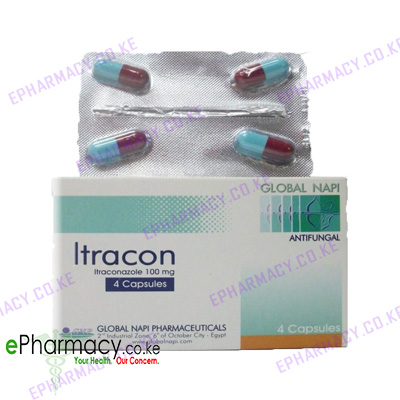
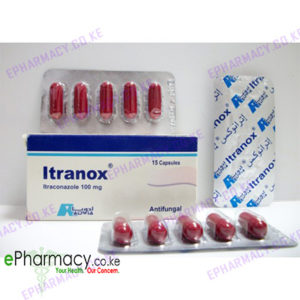
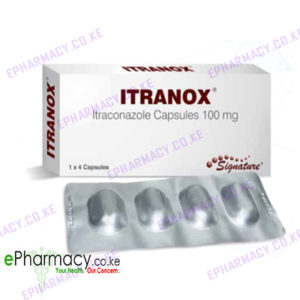
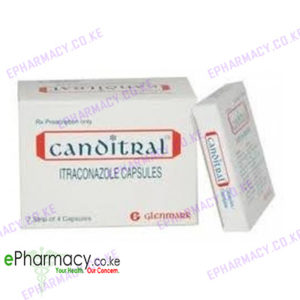
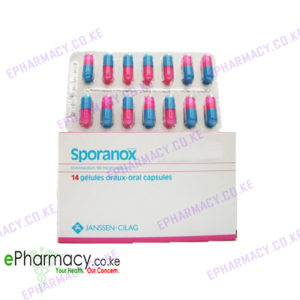
Reviews
There are no reviews yet.